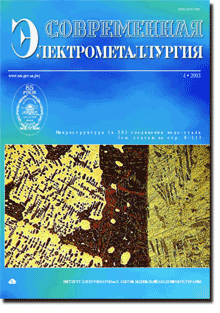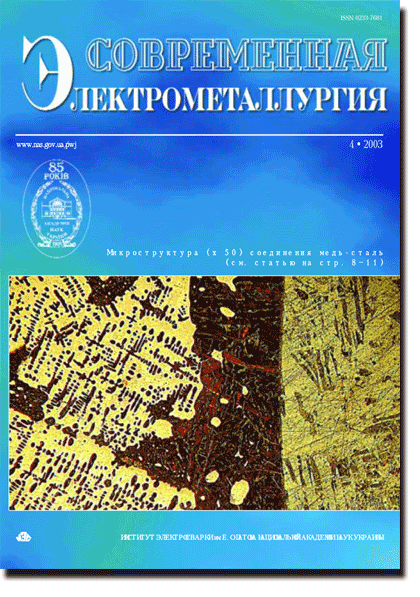| 2003 №03 | 2004 №01 |

CONTENTS

SPECIAL ELECTROMETALLURGY
Paton B.E., Lakomsky V.I., Grigorenko G.M. and Medovar L.B. Special electrometallurgy: Half a century of activity. What next? P. 2
The tendencies in the development of basic processes of special electrometallurgy such as VAR, ESR, EBR and PAR are considered. It is shown that the improvement of these processes should be realized by control of metal behaviour in solidification to attain the optimum service properties.
ELECTROSLAG TECHNOLOGY
Paton B.E., Medovar L.B., Shevchenko V.E., Saenko V.Ya. and Chernets A.V. Electroslag technologies in production of bimetal billets. P. 7
It is shown that the application of electroslag technological processes using a liquid metal and electroslag remelting of a consumable electrode by a double-circuit diagram, developed recently, in the production of bimetal billets makes it possible to solve the major problems connected with the guarantee of uniform and strictly preset depth of penetration of the base layer of bimetal and feasibility of its cladding with materials of the most different chemical composition, such as cast iron, copper, corrosion-resistant, wear-resistant and high-speed steels, heat-resistant nickel alloys and others.
Grigorenko G.M., Lakomsky V.V., Ryabtsev A.D., Pomarin Yu.M., Troyansky A.A. and Orlovsky V.Yu. About the feasibility of nitrogen transport through fluoride slags, containing metal calcium, in ESR. P. 11
Feasibility of metal saturation with nitrogen from the gas phase in electroslag remelting in a chamber-type furnace using a calcium fluoride with metal calcium additions as a slag has been investigated. It is shown that additions of metal calcium promote the nitrogen transport and hinder the oxygen transport from the gas phase to metal.
Biktagirov F.K. Sulphide capacity of oxide-fluoride slags. P. 13
Sulphide capacity of oxide-fluoride slags of CaF2-CaO-Al2O3-SiO2 system has been determined. It is shown that slags with 20-30 % calcium fluoride content possess the best sulphur-absorbing properties. To preserve the sulphide capacity at high level, the concentration of silica should not exceed 10-15 %. It was established that with increase in temperature from 1500 to 1700 oC the sulphide capacity of slags investigated is approximately twice increased.
ELECTRON BEAM PROCESSES
Pikulin A.N., Zhuk G.V., Trigub N.P. and Akhonin S.V. Electron beam surface melting of titanium ingots. P. 16
Technology of electron beam melting of a lateral surface of refractory metal ingots has been developed. As a result of optimizing the conditions of melting of the titanium alloy ingot surface, the parameters of the process are established, which allow the surface layer to be melted for 0.01 m depth, thus eliminating completely the surface defects and ensuring conformity of chemical composition of the remelted layer to the standard requirements.
Zhuk G.V., Trigub N.P. and Zamkov V.N. Producing of titanium gamma-aluminide ingots using EB’HM method. P. 19
Experimental meltings of ingots from titanium gamma-aluminide Ti-47Al-2Nb-1.5Cr in electron beam furnace with a cold hearth have been performed. Optimum technological condition of remelting was determined by the method of a mathematical modelling of process of the ingot formation. Structure and chemical composition of ingots were examined.
Nakonechny N.F., Fyodorov V.N. and Shchyokin-Krotov V.A. About functioning of intermediate crucible in EBICR of titanium alloys. P. 22
Operation of an intermediate crucible in an electron beam installation during remelting of scrap of titanium alloys was investigated at the Electron Beam Metallurgical Plant of FIKO, Ltd. Heat balance of the melting process and temperature field of a molten pool are described. The feasibility of a noticeable deepening of the molten pool with increase in skull plate thickness and thermal resistance at the boundary between the skull and intermediate crucible is shown. Increase in efficiency factor of the process is predicted from 30 to 70 % at increase in the melting speed from 0.1 to 1 kg/s.
PLASMA-ARC TECHNOLOGY
Zhadkevich M.L., Shapovalov V.A., Torkhov G.F., Granovsky V.K. and Nikitenko Yu.A. Producing of amorphous and nanocrystal materials using plasma-arc heating (Review). P. 28
Basic methods of producing amorphous and nanocrystal metallic materials are reviewed. Peculiarities of properties of these materials in comparison with similar alloys with a crystalline structure are distinguished. Challenging trends in application of amorphous metals are indicated. Method of spinning is presented in detail and a pilot installation with a plasma-arc heating for melting and casting of metals and alloys with different physical-chemical properties into an amorphous strip is described.
VACUUM-INDUCTION MELTING
Shejko I.V. and Grigorenko G.M. Induction heating. Capabilities and prospects of application in special electrometallurgy. Part 2. Methods and equipment for induction melting of metals at melt contact with crucible wall. P. 34
Review and analysis of capabilities and basic technical characteristics of channel-type induction furnaces used in industry for melting metals and alloys are presented. Specifics of operation and design of these units are outlined. Technical characteristics of AC plasma-arc heaters of 300 and 450 kW capacity, developed at the E.O. Paton Electric Welding Institute of the NAS of Ukraine for intensification of melting in open and vacuum-induction furnaces with a crucible capacity of not less than 1
GENERAL PROBLEMS OF METALLURGY
Grigorenko G.M., Pomarin Yu.M., Orlovsky V.Yu., Lakomsky V.V. and Statkevich I.I. Specifics of kinetics of nitrogen absorption by molten niobium. P. 42
Kinetic relationships of nitrogen absorption from the gas phase by molten niobium are presented within the wide range of temperatures and partial pressures of nitrogen. Interaction was studied using a method of a levitation melting. It is shown that the gas concentration in metal is described by the second-order equation, and a chemico-absorbing link is a limiting stage of the process. Values of chemical reaction rates have been calculated at different temperatures and partial pressures of nitrogen in the gas phase.
ENERGY AND RESOURCE SAVING
Bykovets V.V. and Lakomsky V.I. Specific electric resistance of thermal anthracite. P. 46
Results of measurement of a specific electric resistance of thermoanthracite in a monolith are presented and a value of temperature coefficient of this resistance is determined. This parameter is very important for calculation of processes of direct heating of thermoanthracite in shaft electric furnaces. Thermoantracite was produced from coal of Central factory "Obukhovskaya" of the "Gukovanthracite" concern at the enterprise OJSC "Ukrainian Graphite".
Index of articles for ASEM'2003, No.1-4. P. 49
List of authors. P. 50
(You are viewing the simplified file contents)
Sorry, the PDF of this issue is not yet available
The cost of subscription/purchase order journals or individual articles
| Journal/Currency | Annual Set | 1 issue printed |
1 issue |
one article |
| TPWJ/USD | 384 $ | 32 $ | 26 $ | 13 $ |
| TPWJ/EUR | 348 € | 29 € | 24 € | 12 € |
| TPWJ/UAH | 7200 UAH | 600 UAH | 600 UAH | 280 UAH |
| AS/UAH | 1800 UAH | 300 UAH | 300 UAH | 150 UAH |
| AS/USD | 192 $ | 32 $ | 26 $ | 13 $ |
| AS/EUR | 180 € | 30 € | 25 € | 12 € |
| SEM/UAH | 1200 UAH | 300 UAH | 300 UAH | 150 UAH |
| SEM/USD | 128 $ | 32 $ | 26 $ | 13 $ |
| SEM/EUR | 120 € | 30 € | 25 € | 12 € |
| TDNK/UAH | 1200 UAH | 300 UAH | 300 UAH | 150 UAH |
| TDNK/USD | 128 $ | 32 $ | 26 $ | 13 $ |
| TDNK/EUR | 120 € | 30 € | 25 € | 15 € |
AS = «Automatic Welding» - 6 issues per year;
TPWJ = «PATON WELDING JOURNAL» - 12 issues per year;
SEM = «Electrometallurgy Today» - 4 issues per year;
TDNK = «Technical Diagnostics and Non-Destructive Testing» - 4 issues per year.





